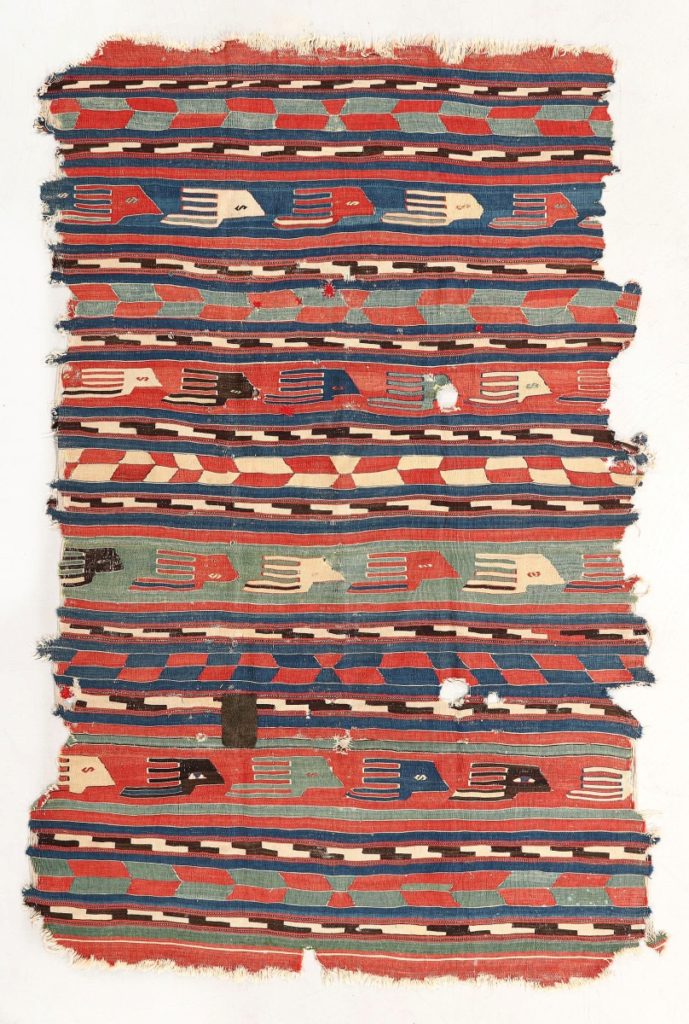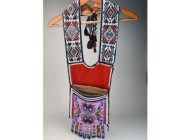
Early central Anatolian kilim, Seventeenth or Eighteenth Century, sold for an incredible $187,500 ($10/20,000).
Review by Z.G. Burnett, Photos Courtesy of Material Culture
PHILADELPHIA — On June 26, Material Culture conducted an auction of fine rugs, kilims and textiles, featuring the collection of Jack Cassin, who passed away in 2021. An expert in the field of Oriental carpets, Cassin wrote multiple books on the subject, including Image, Idol, Symbol; Ancient Anatolian Kilims (1989). The scarce two-volume set focuses on nine plates of rugs in Cassin’s personal collection, which he never sold during his lifetime. Seven out of those nine examples were offered in this sale.
Cassin’s high profile in the field and the superior quality of the lots guaranteed interest; bidders flew in from Italy and Turkey, and there was phone activity from Switzerland, Germany and France, among other American and international bidders. “[Fine carpets are] a small world; there was a lot of attention from rug collectors,” said George Jevremovic, founder and principal auctioneer at Material Culture. “The social media sites were all lit up before and after.” The sale had impressive results and even broke a few records, achieving a total of $1.3 million.
The top four lots were kilims, which are distinguished from other carpets by their flat tapestry weave, without piles, and originate from the Anatolia area of Turkey. They are made by interweaving various colors of wefts and warps, often woven with the slitweave technique to create intricate geometric patterns. Each of the kilims far exceeded their estimates, all of which were $10/20,000 and offered with no reserve. In 2018 a kilim sold for $49,232 (converted from Euros), which was an international record for rugs of this kind, and many lots in this sale multiplied that price.

Shifting to the northwest of Turkey, the next kilim was an Eighteenth Century example from Balıkesir, located in the Marmara region. Also late of the Cassin collection, it was Plate 3 in his book, Image, Idol, Symbol. The kilim sold for $87,500.
The highest price was fetched by an early central Anatolian kilim from the Seventeenth or Eighteenth Century that stunned at $187,500 and is a new record for a kilim. The rug is featured as Plate 5 in Cassin’s Image, Idol, Symbol. Kilims like this and others offered in the sale a “deep-rooted tradition in Turkey, even more so than rugs,” said Jevremovic. “Their designs represent archetypal, spiritual or even pagan beliefs that go back thousands of years, even to cave drawings. People who study kilims look for the purest examples combined with age.” This and the kilims that followed were the definition of both attributes.
Following in the top prices was a central Anatolian rug fragment of the same age as the previous lot, but this hailed from the city of Konya. Unlike kilims, this fragment had a wool pile as well as a warp and weft; it achieved $64,000.
Also from the Cassin collection was an early Nineteenth Century Transcaucasus Shahsevan double saddlebag, or khorjin, bagface that sold for $36,250. The face shows a sumac or soumak weave, which is like a kilim’s flat weave but thicker, with a smooth front face and shaggy reverse.
The last of the top lots, this time from the Leigh Marsh Collection, was another khorjin bagface from the Shahsevan tribe, dating from the early to mid-Nineteenth Century. The geometric central design is similar to many examples from this period. This khorjin bagface carried $32,000; this and the other saddle bagface in the sale are thought to be among the highest prices paid for bagfaces at auction.
Prices quoted include the buyer’s premium as reported by the auction house. Material Culture’s live showroom auction, The World Is Flat; A Kilim By Any Name will take place on August 11. For more information, www.materialculture.com or 215-438-4700.












